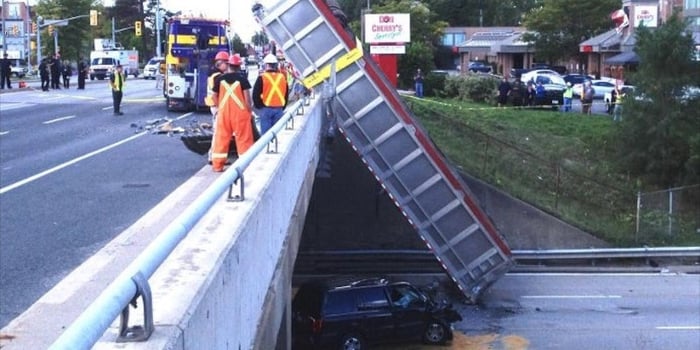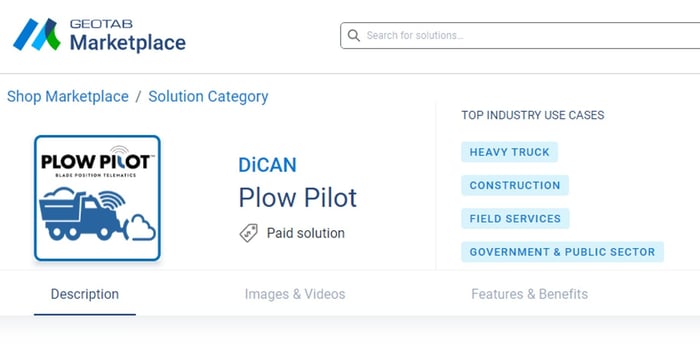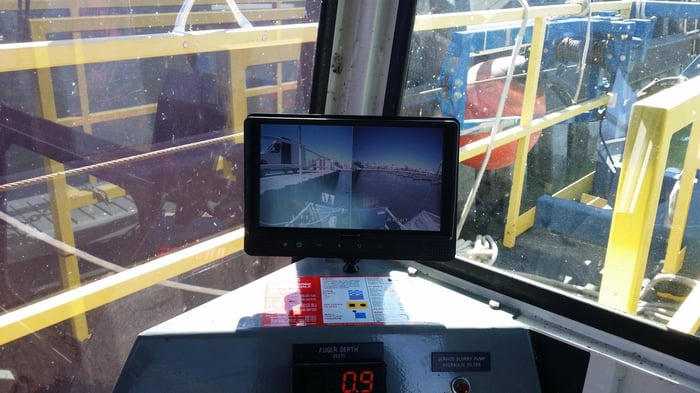TECH REVIEW: Raised Box Indicators
Written by Steve Boss | Read
Table of Contents
Overview
UNARMED AND DANGEROUS A TECH REVIEW: WARNING DEVICES USED TO ALERT BOX UP
Raised Dump Truck Slams into Overpass on Highway Causing Perilous Gash. A headline heard far too often. No one ever believes this could happen to them. Are fleet supervisors choosing fail safe mechanisms to warn their operators and mitigate risk?
No doubt every Ontarian will recall the Burlington Skyway accident Civic Holiday weekend in 2014, the most legendary of any raised dump box accidents. When it comes to tipper truck road safety, the government of Quebec is the first in Canada to implement Highway Safety Code amendments. Effective September 1, the SAAQ regulation requires all vehicles with a raised bed, operating in or travelling through the province, be equipped with flashing red warning lights and audible alerts. Could it be only a matter of time until the Ministry of Transportation implements similar equipment regulations for Ontario fleets.
The driver had just finished dumping his load at a worksite about 200 meters away. Failing to lower the dump bed, continued south when the raised bed of his dump truck collided with the overpass causing an impact so strong it shaped a crack into the concrete more than 8-meters wide. According to dash camera footage, the dump bed first detached from the trailer then the cab pulled a wheelie before coming to rest across oncoming lanes.
Which Switch is Which?
Presence sensing devices of various functional types are used in almost every industrial environment. Dump truck box-up sensors vary from the most basic of stand-alone switches, to some that tie into the vehicle ECU, to patented-technology that not only alerts the operator but fleet control operations back at the office as well. From contact to non-contact, hydraulic, inductive or capacitive, and even photoelectric mechanisms, how does a fleet manager choose?
Micro Switches: Roller, Lever, Whisker Arm, Plunger, Limit
These snap-action switches are basic mechanisms, inexpensive to purchase and are easily installed. For many, this low-cost option may be tempting. However, more suited for the manufacturing line than vehicle installations, these switches are prone to rust and take on dirt and grime when exposed to outdoor elements. Not typically IP rated, the rubber boot at the end of the mechanism can take on water, salt, brine and other contaminants causing the mechanism to “rust off”. Corrosion prohibits rollers from turning, causes plungers to seize and lever arms to break, producing a failure point on the switch.
In all types of micro switches, the actuating mechanism requires direct contact with an external component. Like all things that operate with contact, repetition leads to wear and tear requiring parts replacement on a frequent basis.
The whisker arm is subject to all the above and is most easily bypassed by annoyed dump truck operators, who simply tie down the whisker with tape or cable tie to deliver a false positive reading.
Hydraulic Pressure Switches:
In dump trucks, the raising and lowering of the hydraulic cylinder or hoist raises and lowers the dump box. Pressure-actuated switches can be used to detect box position via changes in pressurized fluids.
This old-school solution can be costly and labour-intensive up front as it requires certified plumbing with the vehicle body hoist cylinder. “Stiction” is an inherent problem, these switches tend to seize and stick far too quickly giving false positives. Not to mention, hydraulic fluids can and do leak, making this a caustic and very messy solution.
Proximity Sensors: Photoelectric
This technology uses a through-beam to detect and object. When the light beam from the transmitter is blocked from getting to the receiver, an object is sensed. These sensors are exceptionally reliable and relatively easy to install. They perform best in controlled environments like an electric eye for a garage door opener or certain types of smoke detectors.
In vehicle applications, they do not require mechanical switches or connection to hydraulic components of the truck. However, exposure to weather, wind and debris can obscure the target and/or beam, causing incessant failures.
Proximity Sensors:
Proximity sensors are inductive, requiring power to operate, and emit an electromagnetic field. They can have a high reliability and long functional life because of the absence of mechanical parts and lack of physical contact between the sensor and the sensed object.
Regardless of production standards, from entry-level product manufactured offshore to high-end devices with prestigious International engineering, when impacted by debris, salt and mud, the 3-pin connector can break. Outside of the typical weather-related failures, sensing capacity can be easily bypassed by simply putting a metal washer on the sensing surface.
When used to detect box position on dump trucks, the variation and movement typically caused by pin wear or cornering can change the gap distance between body and sensor, resulting in false alerts. This type of wear can easily trip the sensor permanently, requiring total replacement and out of service time for vehicles.
Non-Contact Magnetic Reed Switch:
In its simplest and most common form, a reed switch consists of a pair of magnetic contacts hermetically sealed in a glass envelope. This process provides for an air-tight, weather-protected casing that is highly resistant to dirt and contaminants.
Magnetic switches are easily installed and do not require a power source. They offer a wide sensing distance, high tolerance to misalignment and shock, and perform well amid high humidity, temperature swings, and salt spray. Reed switch contacts made from rhodium are especially resistant to corrosion and are virtually indestructible.
In Short
The Non-Contact Mag Reed Switch is the most reliable, precise, maintenance-free, temper-resistant mechanism for dump box position sensing. Its middle-of-the-road purchase price and trouble-free installation is a win-win. Ontario weather allows for year-round dump truck operation; despite heavy snow, thick ice or mud, a magnetic switch will consistently function well. Finally, this type indicator has a long-life expectancy, keeping your fleet out of the shop, working in the field, earning revenue for your business. That’s smart fleet operations.
As published in Ontario Construction News - May 22, 2020





